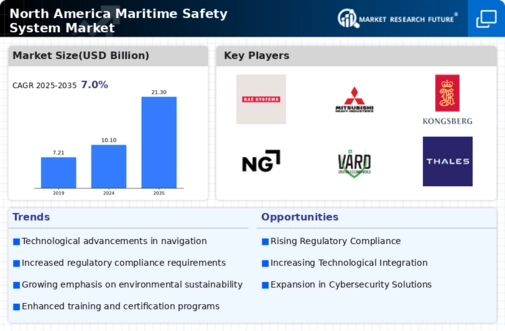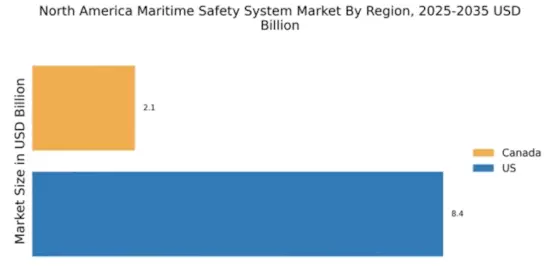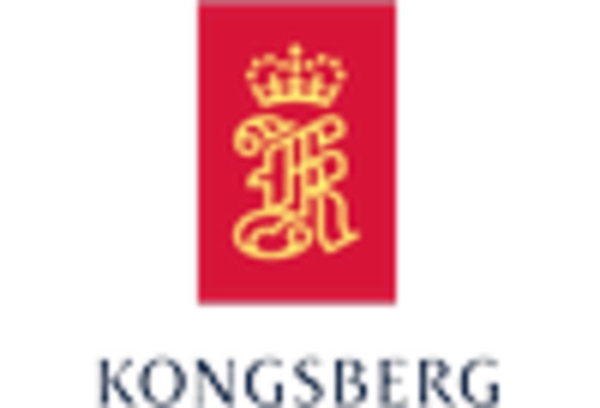Technological Integration
The integration of advanced technologies into maritime safety systems is a pivotal driver for the maritime safety-system market in North America. Innovations such as artificial intelligence, machine learning, and IoT are being increasingly adopted to enhance situational awareness and decision-making processes. For instance, the implementation of AI-driven analytics can improve risk assessment and incident response times. In 2025, it is estimated that the adoption of these technologies could lead to a 20% reduction in maritime accidents. This technological evolution not only enhances safety but also optimizes operational efficiency, making it a crucial factor for stakeholders in the maritime safety-system market. As companies seek to leverage these advancements, the demand for integrated safety solutions is likely to escalate, further propelling market growth.
Increasing Maritime Traffic
the maritime safety-system market in North America is growing due to the rising volume of maritime traffic. As trade and commerce expand, the number of vessels navigating North American waters increases, necessitating enhanced safety measures. In 2025, the U.S. Coast Guard reported a 15% rise in commercial shipping activity compared to previous years. This surge in maritime operations amplifies the demand for advanced safety systems to mitigate risks associated with collisions, groundings, and other maritime incidents. Consequently, stakeholders in the maritime safety-system market are compelled to innovate and implement robust safety protocols to ensure the protection of lives and cargo. The increasing maritime traffic thus serves as a significant driver for the maritime safety-system market, prompting investments in technology and infrastructure to enhance safety standards.
Investment in Infrastructure
Investment in maritime infrastructure is a critical driver for the maritime safety-system market in North America. The government and private sector are increasingly allocating funds to upgrade ports, navigation aids, and communication systems. In 2025, it is projected that infrastructure spending in the maritime sector will exceed $10 billion, reflecting a commitment to enhancing safety and efficiency. Improved infrastructure facilitates better monitoring and management of maritime activities, thereby reducing the likelihood of accidents. This influx of capital not only supports the development of advanced safety systems but also encourages innovation within the maritime safety-system market. As infrastructure continues to evolve, the market is expected to benefit from enhanced safety measures and operational capabilities.
Growing Environmental Concerns
Environmental concerns are becoming a prominent driver for the maritime safety-system market in North America. As awareness of ecological impacts increases, there is a growing emphasis on sustainable practices within the maritime industry. Regulations aimed at reducing emissions and protecting marine ecosystems are prompting companies to adopt safety systems that align with environmental standards. In 2025, it is anticipated that compliance with these regulations will drive a 25% increase in demand for eco-friendly safety solutions. This shift not only addresses environmental challenges but also enhances the overall safety of maritime operations. Consequently, the maritime safety-system market is expected to see a surge in innovations that prioritize both safety and sustainability, reflecting the industry's commitment to responsible practices.
Enhanced Training and Education
Enhanced training and education programs are emerging as a vital driver for the maritime safety-system market in North America. As the complexity of maritime operations increases, there is a pressing need for skilled personnel who are well-versed in safety protocols and emergency response. In 2025, it is estimated that training expenditures in the maritime sector will rise by 30%, reflecting a commitment to improving safety standards. This investment in human capital is crucial for ensuring that crew members are equipped to handle potential hazards effectively. As organizations prioritize training initiatives, the maritime safety-system market is likely to benefit from a more knowledgeable workforce, ultimately leading to improved safety outcomes and reduced incident rates.


















Leave a Comment